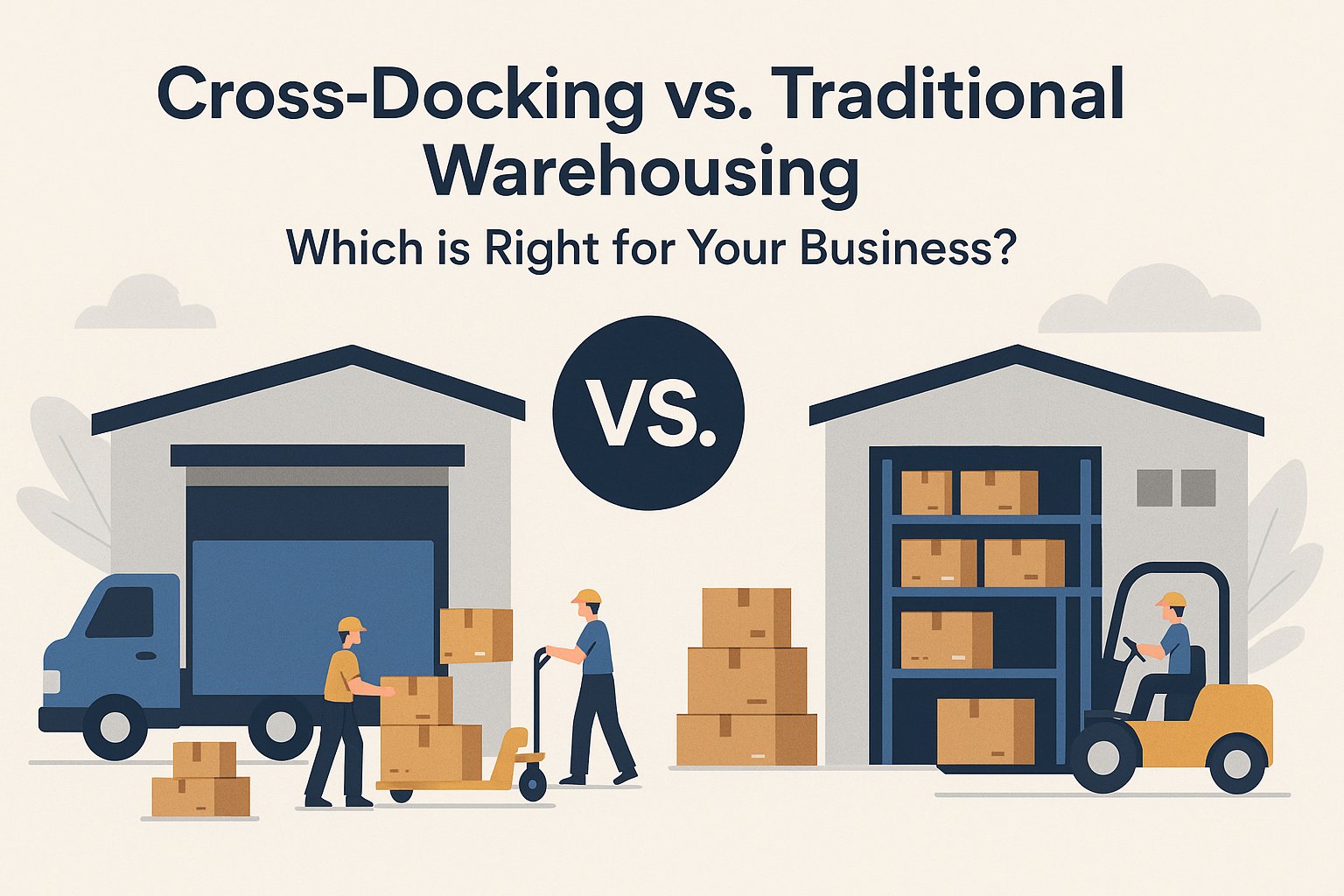In the fast-paced world of modern commerce, optimizing your supply chain isn’t just an advantage—it’s a necessity. Businesses are constantly seeking innovative strategies to reduce costs, enhance efficiency, and accelerate delivery. Two prominent methodologies often stand at the forefront of this discussion: cross-docking and traditional warehousing. While both aim to manage inventory and facilitate product flow, they operate on fundamentally different principles, each offering distinct benefits and challenges.
Understanding which approach aligns best with your operational needs and business goals is crucial for sustainable growth. This comprehensive guide will delve into the intricacies of cross-docking and traditional warehousing, providing a detailed comparison, practical use cases, and actionable insights to help you make an informed decision for your logistics strategy.
Cross-Docking: The Art of Streamlined Logistics
Cross-docking is a logistics strategy where incoming products from a supplier or manufacturing plant are directly transferred to outgoing trucks or trailers with minimal or no storage in between. The core idea is to move products directly from inbound to outbound docks, bypassing the need for long-term storage in a warehouse.
How Does Cross-Docking Work?
Imagine a symphony of synchronized movements. Products arrive at a cross-docking facility, typically sorted and labeled for specific outbound destinations. Upon arrival, they are immediately unloaded, moved across the dock, and reloaded onto waiting outbound vehicles. This process significantly reduces handling, storage time, and associated costs. It’s an ideal solution for goods that are in high demand, perishable, or have a short shelf life.
Types of Cross-Docking
- Manufacturing Cross-Docking: This involves receiving incoming products and matching them to outbound orders or production requirements, ensuring a steady flow of materials to manufacturing lines.
- Distributor Cross-Docking: Products from various vendors are consolidated into mixed loads for delivery to a diverse customer base.
- Transportation Cross-Docking: Consolidates shipments from various carriers in less-than-truckload (LTL) quantities to achieve economies of scale and reduce shipping costs.
- Retail Cross-Docking: Involves receiving products from multiple vendors and consolidating them for delivery to individual retail stores.
Traditional Warehousing: The Backbone of Inventory Management
Traditional warehousing, in contrast, involves storing goods for a period, often weeks or months, before they are picked, packed, and shipped to their final destinations. This method emphasizes inventory holding, allowing businesses to maintain buffer stock, manage seasonal demand, and offer a wide range of products to customers.
The Mechanics of Traditional Warehousing
A traditional warehouse acts as a central hub where goods are received, categorized, put away into storage locations, and then retrieved when an order is placed. This process involves various stages, including receiving, put-away, storage, picking, packing, and shipping. Advanced warehouse management systems (WMS) are often employed to optimize these processes, track inventory in real-time, and improve overall operational efficiency.
Key Characteristics of Traditional Warehousing
- Inventory Buffering: Allows businesses to hold surplus stock to meet unexpected demand fluctuations or supply chain disruptions.
- Consolidation Point: Serves as a central location to consolidate products from various suppliers before distribution.
- Value-Added Services: Often includes services like kitting, assembly, labeling, and quality control.
- Seasonal Demand Management: Ideal for businesses with fluctuating demand throughout the year, allowing them to stock up during off-peak seasons.
Cross-Docking vs. Traditional Warehousing: A Comparative Analysis
Choosing between cross-docking and traditional warehousing is a strategic decision that impacts various aspects of your supply chain. Let’s compare these two approaches across several critical dimensions:
| Feature | Cross-Docking | Traditional Warehousing |
|---|---|---|
| Inventory Holding Time | Minimal to none (hours to a few days) | Significant (weeks to months) |
| Storage Space Required | Less, as goods are not stored long-term | More, dedicated storage areas are essential |
| Operating Costs | Lower due to reduced storage and handling | Higher due to storage, labor, and infrastructure |
| Lead Time | Significantly shorter, faster delivery to customers | Longer, involves more steps in the fulfillment process |
| Product Suitability | Perishable goods, high-demand items, pre-sorted shipments | Wide range of products, seasonal items, those requiring value-added services |
| Complexity | Requires precise coordination and robust IT systems | Requires efficient WMS and well-organized storage |
| Risk of Damage/Loss | Lower due to reduced handling and storage | Potentially higher with more handling and longer storage periods |
| Flexibility | Less flexible for unexpected demand spikes or order changes | More flexible, allows for inventory adjustments and diverse order fulfillment |
Example Usage Scenarios: When to Choose Which?
To illustrate the practical application of each strategy, let’s explore some real-world scenarios:
Case Study 1: Fresh Produce Distributor (Cross-Docking)
A large fresh produce distributor needs to move seasonal fruits and vegetables from farms to supermarkets daily. These products are highly perishable and have a very limited shelf life. Storing them in a traditional warehouse would lead to spoilage and significant losses. By implementing a cross-docking strategy, the distributor can receive produce in the morning and immediately load it onto trucks destined for various grocery stores, ensuring freshness and minimizing waste. This scenario highlights cross-docking’s strength in handling time-sensitive goods.
Case Study 2: E-commerce Fashion Retailer (Traditional Warehousing with Fulfillment)
An online fashion retailer sells a wide variety of clothing, accessories, and footwear. Their product lines change seasonally, and they often run promotions that lead to unpredictable demand spikes. They need to manage returns, offer gift wrapping, and handle a high volume of individual orders. A traditional warehouse model, combined with robust e-commerce fulfillment capabilities, is ideal here. It allows them to store diverse inventory, manage peak seasons, process returns efficiently, and provide value-added services to enhance the customer experience. Companies like WarehouseTX, offering comprehensive fulfillment services, are perfectly suited for such operations.
Case Study 3: Auto Parts Supplier (Hybrid Approach)
An auto parts supplier deals with both fast-moving, high-demand components (e.g., oil filters, spark plugs) and slow-moving, specialized parts (e.g., vintage car components). For the high-demand parts, a cross-docking approach can ensure rapid replenishment to service centers. However, for the specialized parts, traditional warehousing is essential to maintain a stable inventory and fulfill infrequent but critical orders. This scenario demonstrates the potential for a hybrid strategy, leveraging the strengths of both methods to optimize different product categories.
Factors to Consider When Making Your Decision
Choosing between cross-docking and traditional warehousing isn’t a one-size-fits-all decision. Several factors will influence the best approach for your business:
1. Product Characteristics
- Perishability: Highly perishable goods (e.g., fresh food, flowers, pharmaceuticals) are ideal for cross-docking.
- Volume and Predictability: High-volume, consistently demanded products with predictable flow suit cross-docking. Low-volume, unpredictable, or highly varied items often benefit from traditional warehousing.
- Value-Added Services: If your products require kitting, assembly, customization, or extensive quality control before shipment, traditional warehousing offers the necessary space and time.
2. Demand Patterns
- Consistent Demand: Businesses with stable, predictable demand can leverage cross-docking for continuous product flow.
- Seasonal or Fluctuating Demand: Traditional warehousing provides the flexibility to stock up during off-peak seasons and manage inventory during peak times.
3. Supply Chain Network
- Supplier and Customer Proximity: Cross-docking is most effective when suppliers are reliable and delivery routes to customers are well-defined and geographically concentrated.
- Geographic Reach: If you serve a wide geographic area with diverse customer needs, a network of strategically located warehouses (like those offered by WarehouseTX’s nationwide network in Texas, Miami, California, Iowa, Virginia, and New Jersey) can optimize delivery times.
4. Technology and Infrastructure
- Advanced WMS: Both approaches benefit from robust warehouse management systems. For cross-docking, real-time data and precise coordination are paramount.
- Material Handling Equipment: Cross-docking facilities require efficient conveyors and sorting equipment, while traditional warehouses need varied equipment for storage and retrieval.
5. Cost Implications
- Operating Costs: Analyze the costs associated with labor, rent, utilities, and equipment for both models. Cross-docking generally has lower operating costs, but requires higher initial investment in a well-designed facility and IT.
- Inventory Carrying Costs: Traditional warehousing incurs higher inventory carrying costs due to longer storage times.
Why a Hybrid Approach Might Be Your Best Bet
For many businesses, a pure cross-docking or traditional warehousing model may not be the optimal solution. A **hybrid approach** often provides the best of both worlds. This involves integrating elements of both strategies within your supply chain:
- Utilizing cross-docking for fast-moving, high-volume products.
- Maintaining traditional warehousing for slow-moving, high-value, or customizable items.
- Leveraging a network of secure and scalable US warehousing for strategic inventory placement.
This flexible approach allows businesses to optimize efficiency where possible while maintaining the necessary inventory buffers and service capabilities for their entire product range. A third-party logistics (3PL) provider like WarehouseTX can be invaluable in designing and implementing such a sophisticated, tailored solution, handling everything from return management to custom packaging and packing.
The Role of 3PL Providers in Supply Chain Optimization
Partnering with a reputable 3PL provider can significantly simplify the decision-making process and execution of either cross-docking or traditional warehousing, or even a hybrid model. 3PLs offer:
- Expertise: In-depth knowledge of logistics and supply chain best practices.
- Infrastructure: Access to state-of-the-art facilities, technology, and equipment without significant capital investment.
- Scalability: The ability to scale operations up or down based on your business needs.
- Cost Savings: Often achieve economies of scale that individual businesses cannot.
- Risk Mitigation: Help navigate supply chain complexities and disruptions.
WarehouseTX, with its extensive experience in logistics solutions, provides secure and scalable US warehousing, real-time inventory tracking, and efficient eCommerce fulfillment solutions. Their strategically located fulfillment centers across the U.S. ensure faster delivery times and reduced shipping costs, whether you opt for cross-docking, traditional warehousing, or a combination.
Frequently Asked Questions (FAQ)
What are the main benefits of cross-docking?
The primary benefits of cross-docking include significantly reduced inventory holding costs, faster order fulfillment and delivery times, less need for storage space, and reduced labor costs associated with picking and put-away. It’s particularly beneficial for high-volume, time-sensitive goods.
When is traditional warehousing a better option than cross-docking?
Traditional warehousing is generally preferred when you need to hold buffer stock, manage seasonal demand fluctuations, offer a wide variety of products, require value-added services like kitting or assembly, or deal with unpredictable demand patterns. It provides greater flexibility and allows for more complex inventory management.
Can cross-docking and traditional warehousing be used together?
Yes, a hybrid approach is often the most effective strategy. Businesses can use cross-docking for fast-moving, high-demand products and traditional warehousing for items that require longer storage or additional processing. This allows for optimized efficiency for different product categories within a single supply chain.
What kind of technology is crucial for successful cross-docking?
Successful cross-docking heavily relies on advanced technology. A robust Warehouse Management System (WMS) with real-time tracking, efficient barcode scanning, automated sorting systems, and strong communication tools are crucial. These technologies ensure precise coordination and minimal errors in the rapid movement of goods.
How does cross-docking impact inventory management?
Cross-docking significantly reduces the amount of inventory held at a facility. It shifts the focus from “stocking” to “flow-through,” minimizing inventory carrying costs, obsolescence, and the need for extensive inventory counting. This leads to leaner inventory levels and improved cash flow.
Conclusion: Crafting Your Ideal Logistics Strategy
The choice between cross-docking and traditional warehousing is not merely operational; it’s a strategic decision that can redefine your business’s efficiency, cost structure, and customer satisfaction. While cross-docking offers unparalleled speed and cost savings for specific product types and demand patterns, traditional warehousing provides the necessary flexibility and buffering for diverse inventories and fluctuating markets.
The key lies in understanding your unique business needs, product characteristics, and demand predictability. Many forward-thinking companies are embracing a hybrid model, skillfully blending both approaches to create a resilient and optimized supply chain. By partnering with experienced logistics providers like WarehouseTX, you can navigate these complexities, leverage advanced solutions, and ultimately build a supply chain that not only meets but exceeds the demands of today’s dynamic global marketplace. Invest in the right strategy, and watch your business thrive.

